Legal Systems: Criminal Law, Civil Law, and Contracts Assignment
VerifiedAdded on 2020/03/07
|7
|2183
|48
Homework Assignment
AI Summary
This assignment solution delves into the fundamental differences between criminal and civil law, examining the parties involved, court procedures, and standards of proof. It then addresses contract law, specifically breach of contract remedies available under the Consumer Rights Act 2015, clarifying the distinction between agreements and contracts and the essential elements of a valid contract. Furthermore, the assignment explores negligent misstatements, tracing the evolution of legal principles from Donohue v Stevenson to Hedley Byrne v. Heller, and the conditions under which a party can be held liable for causing damage through such statements, including their relevance in contractual contexts and potential remedies under the Misrepresentation Act 1967. The solution incorporates relevant case laws to support the arguments.
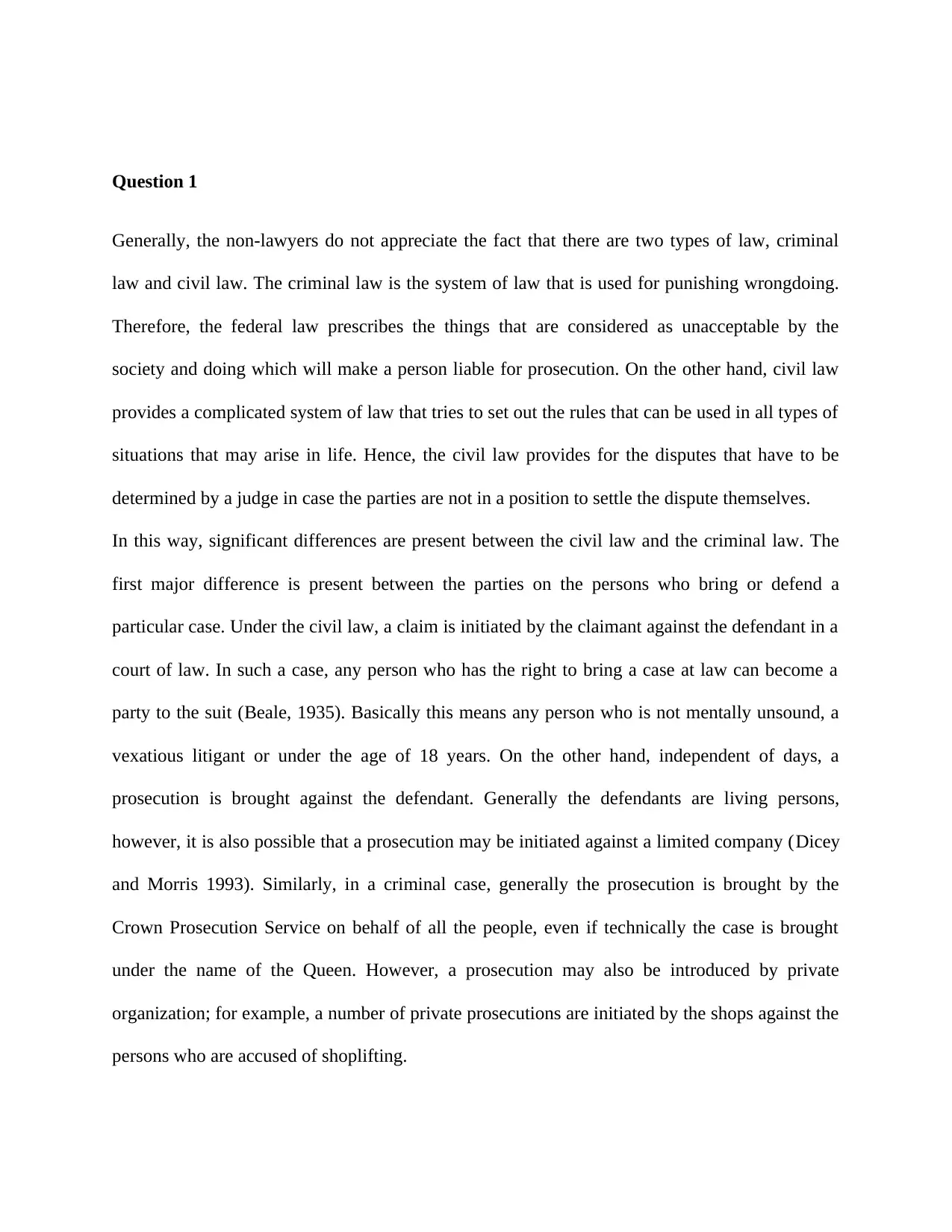
Question 1
Generally, the non-lawyers do not appreciate the fact that there are two types of law, criminal
law and civil law. The criminal law is the system of law that is used for punishing wrongdoing.
Therefore, the federal law prescribes the things that are considered as unacceptable by the
society and doing which will make a person liable for prosecution. On the other hand, civil law
provides a complicated system of law that tries to set out the rules that can be used in all types of
situations that may arise in life. Hence, the civil law provides for the disputes that have to be
determined by a judge in case the parties are not in a position to settle the dispute themselves.
In this way, significant differences are present between the civil law and the criminal law. The
first major difference is present between the parties on the persons who bring or defend a
particular case. Under the civil law, a claim is initiated by the claimant against the defendant in a
court of law. In such a case, any person who has the right to bring a case at law can become a
party to the suit (Beale, 1935). Basically this means any person who is not mentally unsound, a
vexatious litigant or under the age of 18 years. On the other hand, independent of days, a
prosecution is brought against the defendant. Generally the defendants are living persons,
however, it is also possible that a prosecution may be initiated against a limited company (Dicey
and Morris 1993). Similarly, in a criminal case, generally the prosecution is brought by the
Crown Prosecution Service on behalf of all the people, even if technically the case is brought
under the name of the Queen. However, a prosecution may also be introduced by private
organization; for example, a number of private prosecutions are initiated by the shops against the
persons who are accused of shoplifting.
Generally, the non-lawyers do not appreciate the fact that there are two types of law, criminal
law and civil law. The criminal law is the system of law that is used for punishing wrongdoing.
Therefore, the federal law prescribes the things that are considered as unacceptable by the
society and doing which will make a person liable for prosecution. On the other hand, civil law
provides a complicated system of law that tries to set out the rules that can be used in all types of
situations that may arise in life. Hence, the civil law provides for the disputes that have to be
determined by a judge in case the parties are not in a position to settle the dispute themselves.
In this way, significant differences are present between the civil law and the criminal law. The
first major difference is present between the parties on the persons who bring or defend a
particular case. Under the civil law, a claim is initiated by the claimant against the defendant in a
court of law. In such a case, any person who has the right to bring a case at law can become a
party to the suit (Beale, 1935). Basically this means any person who is not mentally unsound, a
vexatious litigant or under the age of 18 years. On the other hand, independent of days, a
prosecution is brought against the defendant. Generally the defendants are living persons,
however, it is also possible that a prosecution may be initiated against a limited company (Dicey
and Morris 1993). Similarly, in a criminal case, generally the prosecution is brought by the
Crown Prosecution Service on behalf of all the people, even if technically the case is brought
under the name of the Queen. However, a prosecution may also be introduced by private
organization; for example, a number of private prosecutions are initiated by the shops against the
persons who are accused of shoplifting.
Secure Best Marks with AI Grader
Need help grading? Try our AI Grader for instant feedback on your assignments.
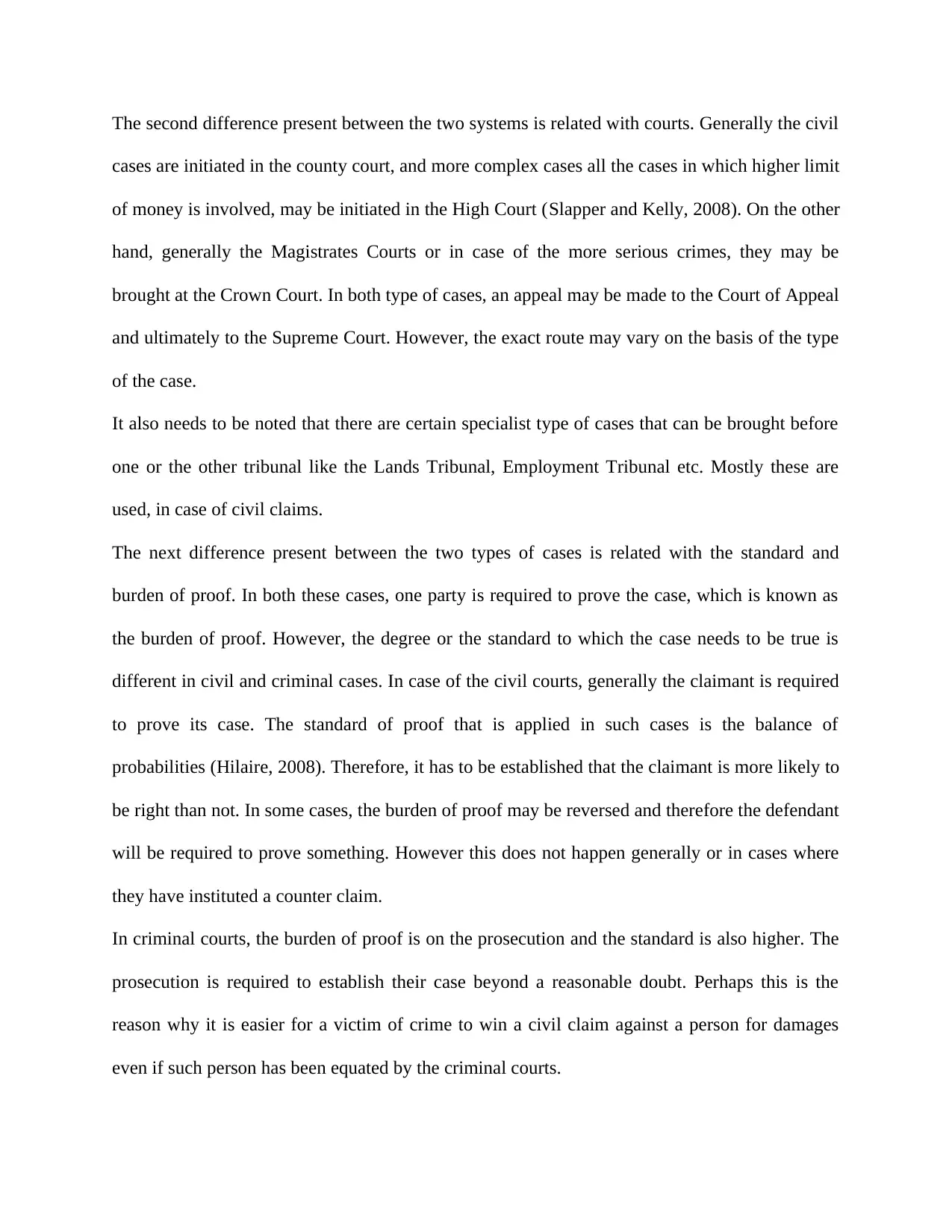
The second difference present between the two systems is related with courts. Generally the civil
cases are initiated in the county court, and more complex cases all the cases in which higher limit
of money is involved, may be initiated in the High Court (Slapper and Kelly, 2008). On the other
hand, generally the Magistrates Courts or in case of the more serious crimes, they may be
brought at the Crown Court. In both type of cases, an appeal may be made to the Court of Appeal
and ultimately to the Supreme Court. However, the exact route may vary on the basis of the type
of the case.
It also needs to be noted that there are certain specialist type of cases that can be brought before
one or the other tribunal like the Lands Tribunal, Employment Tribunal etc. Mostly these are
used, in case of civil claims.
The next difference present between the two types of cases is related with the standard and
burden of proof. In both these cases, one party is required to prove the case, which is known as
the burden of proof. However, the degree or the standard to which the case needs to be true is
different in civil and criminal cases. In case of the civil courts, generally the claimant is required
to prove its case. The standard of proof that is applied in such cases is the balance of
probabilities (Hilaire, 2008). Therefore, it has to be established that the claimant is more likely to
be right than not. In some cases, the burden of proof may be reversed and therefore the defendant
will be required to prove something. However this does not happen generally or in cases where
they have instituted a counter claim.
In criminal courts, the burden of proof is on the prosecution and the standard is also higher. The
prosecution is required to establish their case beyond a reasonable doubt. Perhaps this is the
reason why it is easier for a victim of crime to win a civil claim against a person for damages
even if such person has been equated by the criminal courts.
cases are initiated in the county court, and more complex cases all the cases in which higher limit
of money is involved, may be initiated in the High Court (Slapper and Kelly, 2008). On the other
hand, generally the Magistrates Courts or in case of the more serious crimes, they may be
brought at the Crown Court. In both type of cases, an appeal may be made to the Court of Appeal
and ultimately to the Supreme Court. However, the exact route may vary on the basis of the type
of the case.
It also needs to be noted that there are certain specialist type of cases that can be brought before
one or the other tribunal like the Lands Tribunal, Employment Tribunal etc. Mostly these are
used, in case of civil claims.
The next difference present between the two types of cases is related with the standard and
burden of proof. In both these cases, one party is required to prove the case, which is known as
the burden of proof. However, the degree or the standard to which the case needs to be true is
different in civil and criminal cases. In case of the civil courts, generally the claimant is required
to prove its case. The standard of proof that is applied in such cases is the balance of
probabilities (Hilaire, 2008). Therefore, it has to be established that the claimant is more likely to
be right than not. In some cases, the burden of proof may be reversed and therefore the defendant
will be required to prove something. However this does not happen generally or in cases where
they have instituted a counter claim.
In criminal courts, the burden of proof is on the prosecution and the standard is also higher. The
prosecution is required to establish their case beyond a reasonable doubt. Perhaps this is the
reason why it is easier for a victim of crime to win a civil claim against a person for damages
even if such person has been equated by the criminal courts.
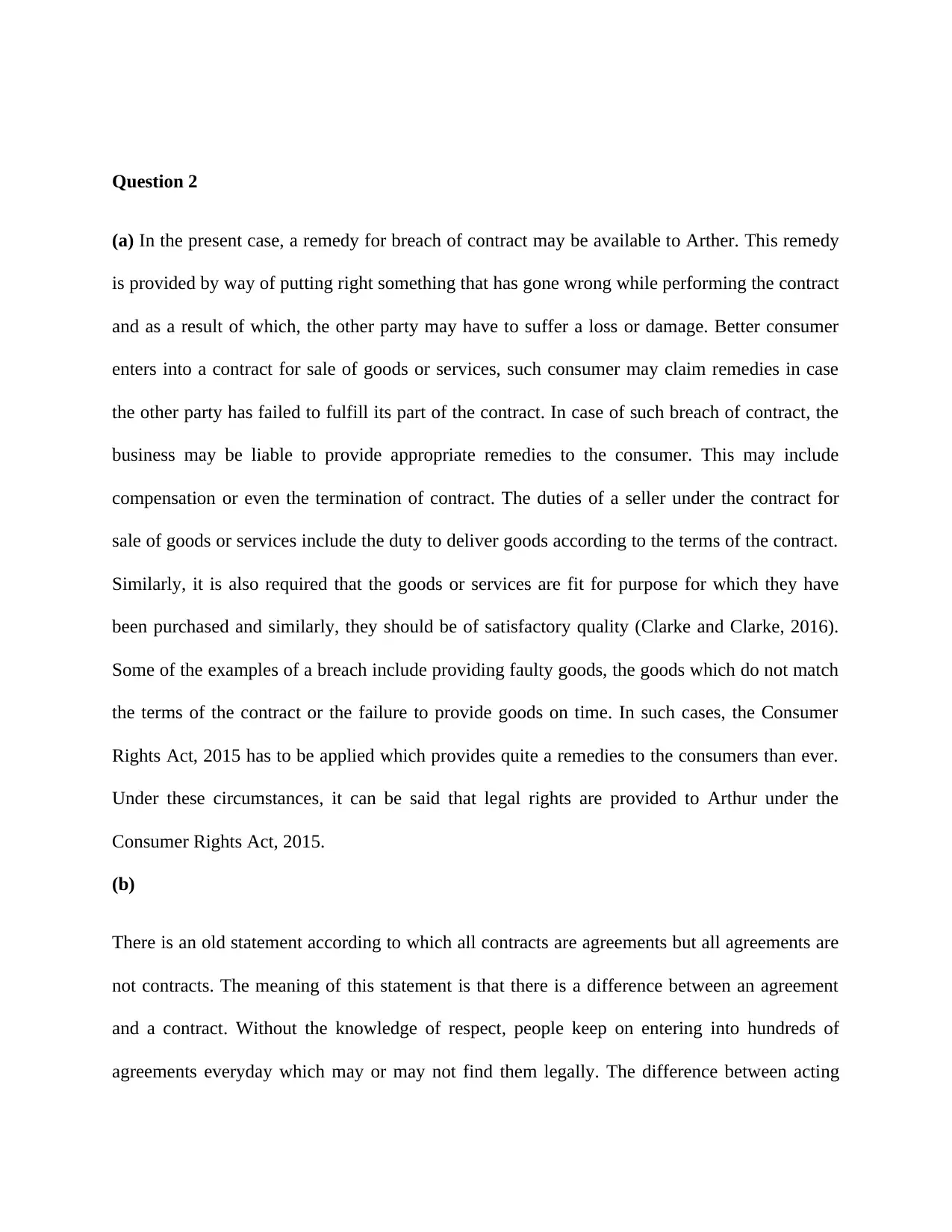
Question 2
(a) In the present case, a remedy for breach of contract may be available to Arther. This remedy
is provided by way of putting right something that has gone wrong while performing the contract
and as a result of which, the other party may have to suffer a loss or damage. Better consumer
enters into a contract for sale of goods or services, such consumer may claim remedies in case
the other party has failed to fulfill its part of the contract. In case of such breach of contract, the
business may be liable to provide appropriate remedies to the consumer. This may include
compensation or even the termination of contract. The duties of a seller under the contract for
sale of goods or services include the duty to deliver goods according to the terms of the contract.
Similarly, it is also required that the goods or services are fit for purpose for which they have
been purchased and similarly, they should be of satisfactory quality (Clarke and Clarke, 2016).
Some of the examples of a breach include providing faulty goods, the goods which do not match
the terms of the contract or the failure to provide goods on time. In such cases, the Consumer
Rights Act, 2015 has to be applied which provides quite a remedies to the consumers than ever.
Under these circumstances, it can be said that legal rights are provided to Arthur under the
Consumer Rights Act, 2015.
(b)
There is an old statement according to which all contracts are agreements but all agreements are
not contracts. The meaning of this statement is that there is a difference between an agreement
and a contract. Without the knowledge of respect, people keep on entering into hundreds of
agreements everyday which may or may not find them legally. The difference between acting
(a) In the present case, a remedy for breach of contract may be available to Arther. This remedy
is provided by way of putting right something that has gone wrong while performing the contract
and as a result of which, the other party may have to suffer a loss or damage. Better consumer
enters into a contract for sale of goods or services, such consumer may claim remedies in case
the other party has failed to fulfill its part of the contract. In case of such breach of contract, the
business may be liable to provide appropriate remedies to the consumer. This may include
compensation or even the termination of contract. The duties of a seller under the contract for
sale of goods or services include the duty to deliver goods according to the terms of the contract.
Similarly, it is also required that the goods or services are fit for purpose for which they have
been purchased and similarly, they should be of satisfactory quality (Clarke and Clarke, 2016).
Some of the examples of a breach include providing faulty goods, the goods which do not match
the terms of the contract or the failure to provide goods on time. In such cases, the Consumer
Rights Act, 2015 has to be applied which provides quite a remedies to the consumers than ever.
Under these circumstances, it can be said that legal rights are provided to Arthur under the
Consumer Rights Act, 2015.
(b)
There is an old statement according to which all contracts are agreements but all agreements are
not contracts. The meaning of this statement is that there is a difference between an agreement
and a contract. Without the knowledge of respect, people keep on entering into hundreds of
agreements everyday which may or may not find them legally. The difference between acting
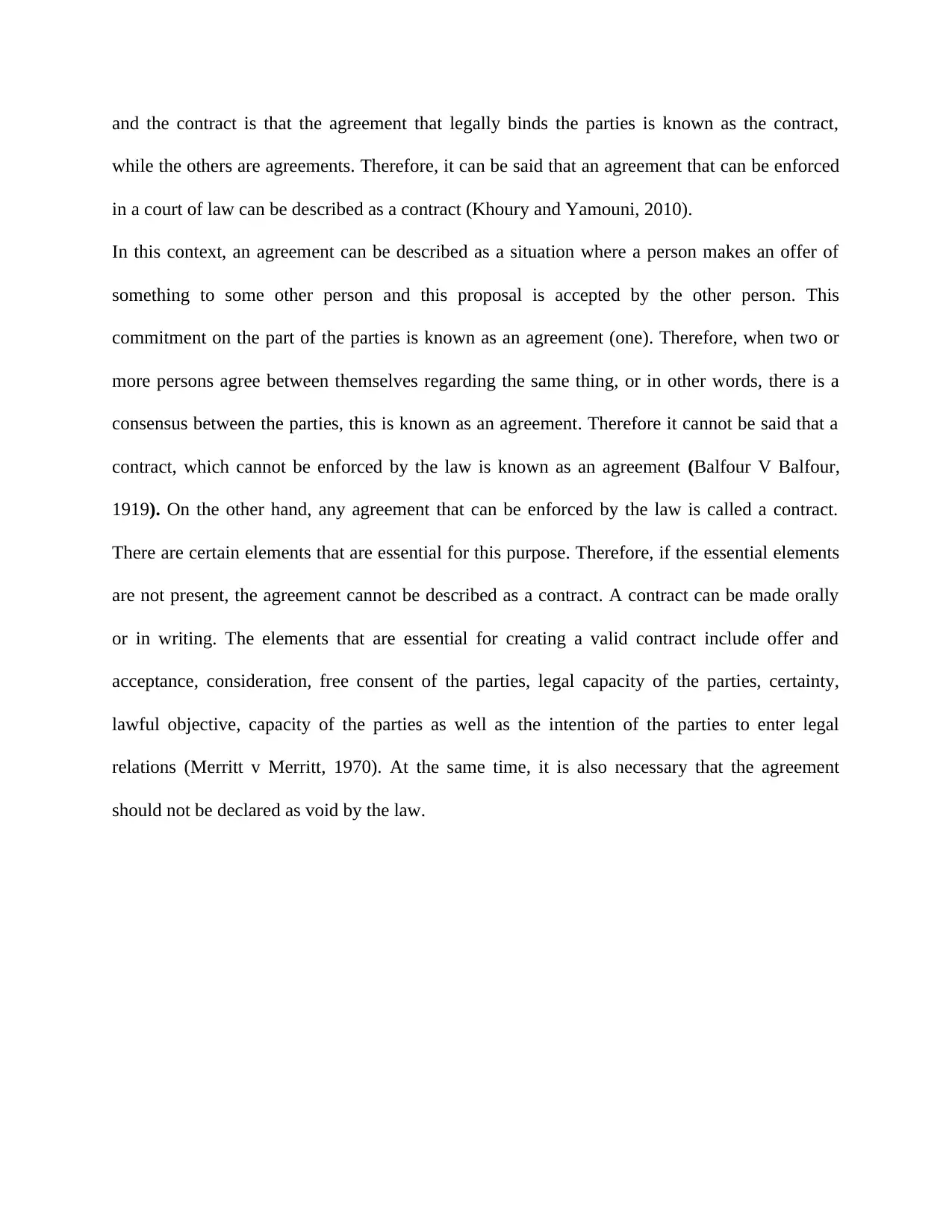
and the contract is that the agreement that legally binds the parties is known as the contract,
while the others are agreements. Therefore, it can be said that an agreement that can be enforced
in a court of law can be described as a contract (Khoury and Yamouni, 2010).
In this context, an agreement can be described as a situation where a person makes an offer of
something to some other person and this proposal is accepted by the other person. This
commitment on the part of the parties is known as an agreement (one). Therefore, when two or
more persons agree between themselves regarding the same thing, or in other words, there is a
consensus between the parties, this is known as an agreement. Therefore it cannot be said that a
contract, which cannot be enforced by the law is known as an agreement (Balfour V Balfour,
1919). On the other hand, any agreement that can be enforced by the law is called a contract.
There are certain elements that are essential for this purpose. Therefore, if the essential elements
are not present, the agreement cannot be described as a contract. A contract can be made orally
or in writing. The elements that are essential for creating a valid contract include offer and
acceptance, consideration, free consent of the parties, legal capacity of the parties, certainty,
lawful objective, capacity of the parties as well as the intention of the parties to enter legal
relations (Merritt v Merritt, 1970). At the same time, it is also necessary that the agreement
should not be declared as void by the law.
while the others are agreements. Therefore, it can be said that an agreement that can be enforced
in a court of law can be described as a contract (Khoury and Yamouni, 2010).
In this context, an agreement can be described as a situation where a person makes an offer of
something to some other person and this proposal is accepted by the other person. This
commitment on the part of the parties is known as an agreement (one). Therefore, when two or
more persons agree between themselves regarding the same thing, or in other words, there is a
consensus between the parties, this is known as an agreement. Therefore it cannot be said that a
contract, which cannot be enforced by the law is known as an agreement (Balfour V Balfour,
1919). On the other hand, any agreement that can be enforced by the law is called a contract.
There are certain elements that are essential for this purpose. Therefore, if the essential elements
are not present, the agreement cannot be described as a contract. A contract can be made orally
or in writing. The elements that are essential for creating a valid contract include offer and
acceptance, consideration, free consent of the parties, legal capacity of the parties, certainty,
lawful objective, capacity of the parties as well as the intention of the parties to enter legal
relations (Merritt v Merritt, 1970). At the same time, it is also necessary that the agreement
should not be declared as void by the law.
Secure Best Marks with AI Grader
Need help grading? Try our AI Grader for instant feedback on your assignments.
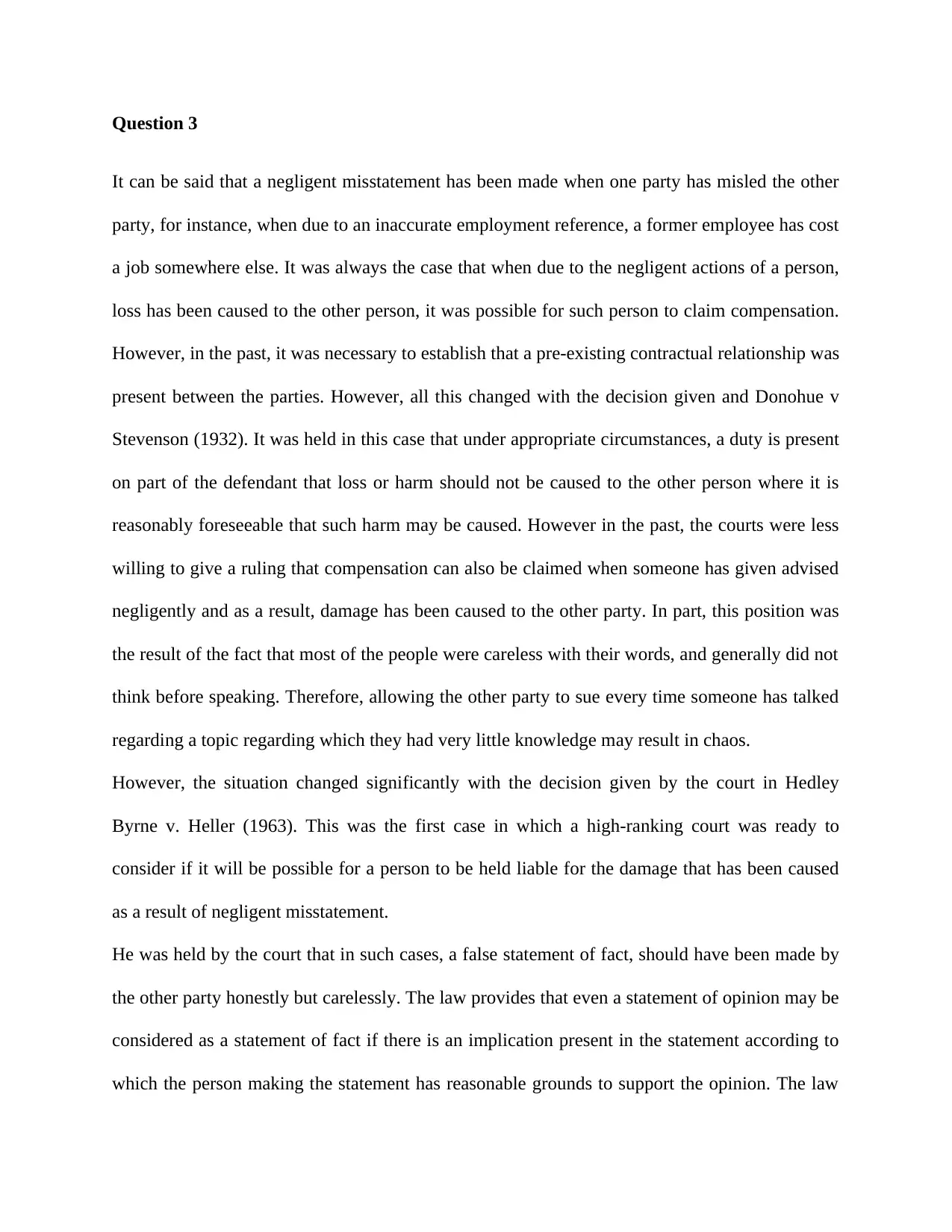
Question 3
It can be said that a negligent misstatement has been made when one party has misled the other
party, for instance, when due to an inaccurate employment reference, a former employee has cost
a job somewhere else. It was always the case that when due to the negligent actions of a person,
loss has been caused to the other person, it was possible for such person to claim compensation.
However, in the past, it was necessary to establish that a pre-existing contractual relationship was
present between the parties. However, all this changed with the decision given and Donohue v
Stevenson (1932). It was held in this case that under appropriate circumstances, a duty is present
on part of the defendant that loss or harm should not be caused to the other person where it is
reasonably foreseeable that such harm may be caused. However in the past, the courts were less
willing to give a ruling that compensation can also be claimed when someone has given advised
negligently and as a result, damage has been caused to the other party. In part, this position was
the result of the fact that most of the people were careless with their words, and generally did not
think before speaking. Therefore, allowing the other party to sue every time someone has talked
regarding a topic regarding which they had very little knowledge may result in chaos.
However, the situation changed significantly with the decision given by the court in Hedley
Byrne v. Heller (1963). This was the first case in which a high-ranking court was ready to
consider if it will be possible for a person to be held liable for the damage that has been caused
as a result of negligent misstatement.
He was held by the court that in such cases, a false statement of fact, should have been made by
the other party honestly but carelessly. The law provides that even a statement of opinion may be
considered as a statement of fact if there is an implication present in the statement according to
which the person making the statement has reasonable grounds to support the opinion. The law
It can be said that a negligent misstatement has been made when one party has misled the other
party, for instance, when due to an inaccurate employment reference, a former employee has cost
a job somewhere else. It was always the case that when due to the negligent actions of a person,
loss has been caused to the other person, it was possible for such person to claim compensation.
However, in the past, it was necessary to establish that a pre-existing contractual relationship was
present between the parties. However, all this changed with the decision given and Donohue v
Stevenson (1932). It was held in this case that under appropriate circumstances, a duty is present
on part of the defendant that loss or harm should not be caused to the other person where it is
reasonably foreseeable that such harm may be caused. However in the past, the courts were less
willing to give a ruling that compensation can also be claimed when someone has given advised
negligently and as a result, damage has been caused to the other party. In part, this position was
the result of the fact that most of the people were careless with their words, and generally did not
think before speaking. Therefore, allowing the other party to sue every time someone has talked
regarding a topic regarding which they had very little knowledge may result in chaos.
However, the situation changed significantly with the decision given by the court in Hedley
Byrne v. Heller (1963). This was the first case in which a high-ranking court was ready to
consider if it will be possible for a person to be held liable for the damage that has been caused
as a result of negligent misstatement.
He was held by the court that in such cases, a false statement of fact, should have been made by
the other party honestly but carelessly. The law provides that even a statement of opinion may be
considered as a statement of fact if there is an implication present in the statement according to
which the person making the statement has reasonable grounds to support the opinion. The law
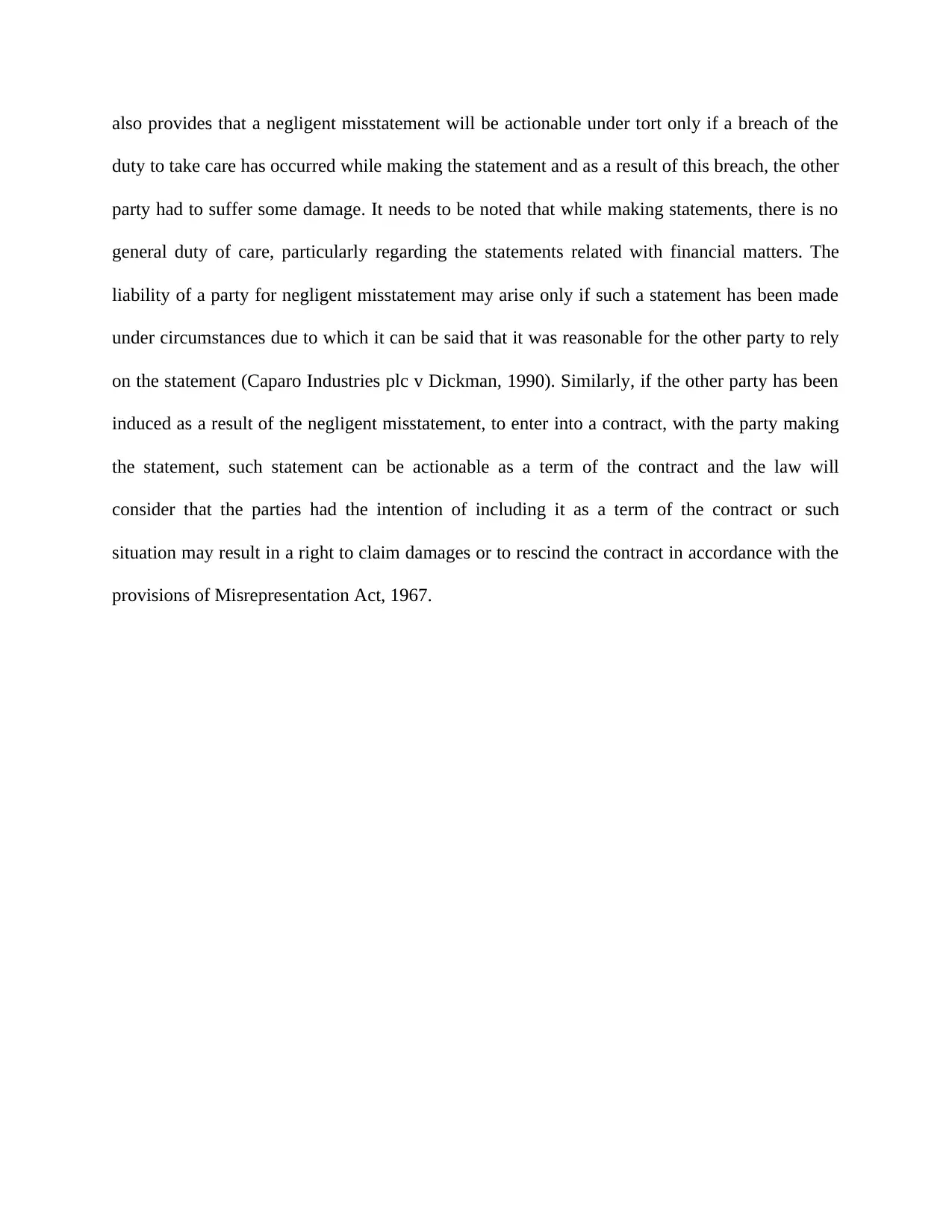
also provides that a negligent misstatement will be actionable under tort only if a breach of the
duty to take care has occurred while making the statement and as a result of this breach, the other
party had to suffer some damage. It needs to be noted that while making statements, there is no
general duty of care, particularly regarding the statements related with financial matters. The
liability of a party for negligent misstatement may arise only if such a statement has been made
under circumstances due to which it can be said that it was reasonable for the other party to rely
on the statement (Caparo Industries plc v Dickman, 1990). Similarly, if the other party has been
induced as a result of the negligent misstatement, to enter into a contract, with the party making
the statement, such statement can be actionable as a term of the contract and the law will
consider that the parties had the intention of including it as a term of the contract or such
situation may result in a right to claim damages or to rescind the contract in accordance with the
provisions of Misrepresentation Act, 1967.
duty to take care has occurred while making the statement and as a result of this breach, the other
party had to suffer some damage. It needs to be noted that while making statements, there is no
general duty of care, particularly regarding the statements related with financial matters. The
liability of a party for negligent misstatement may arise only if such a statement has been made
under circumstances due to which it can be said that it was reasonable for the other party to rely
on the statement (Caparo Industries plc v Dickman, 1990). Similarly, if the other party has been
induced as a result of the negligent misstatement, to enter into a contract, with the party making
the statement, such statement can be actionable as a term of the contract and the law will
consider that the parties had the intention of including it as a term of the contract or such
situation may result in a right to claim damages or to rescind the contract in accordance with the
provisions of Misrepresentation Act, 1967.
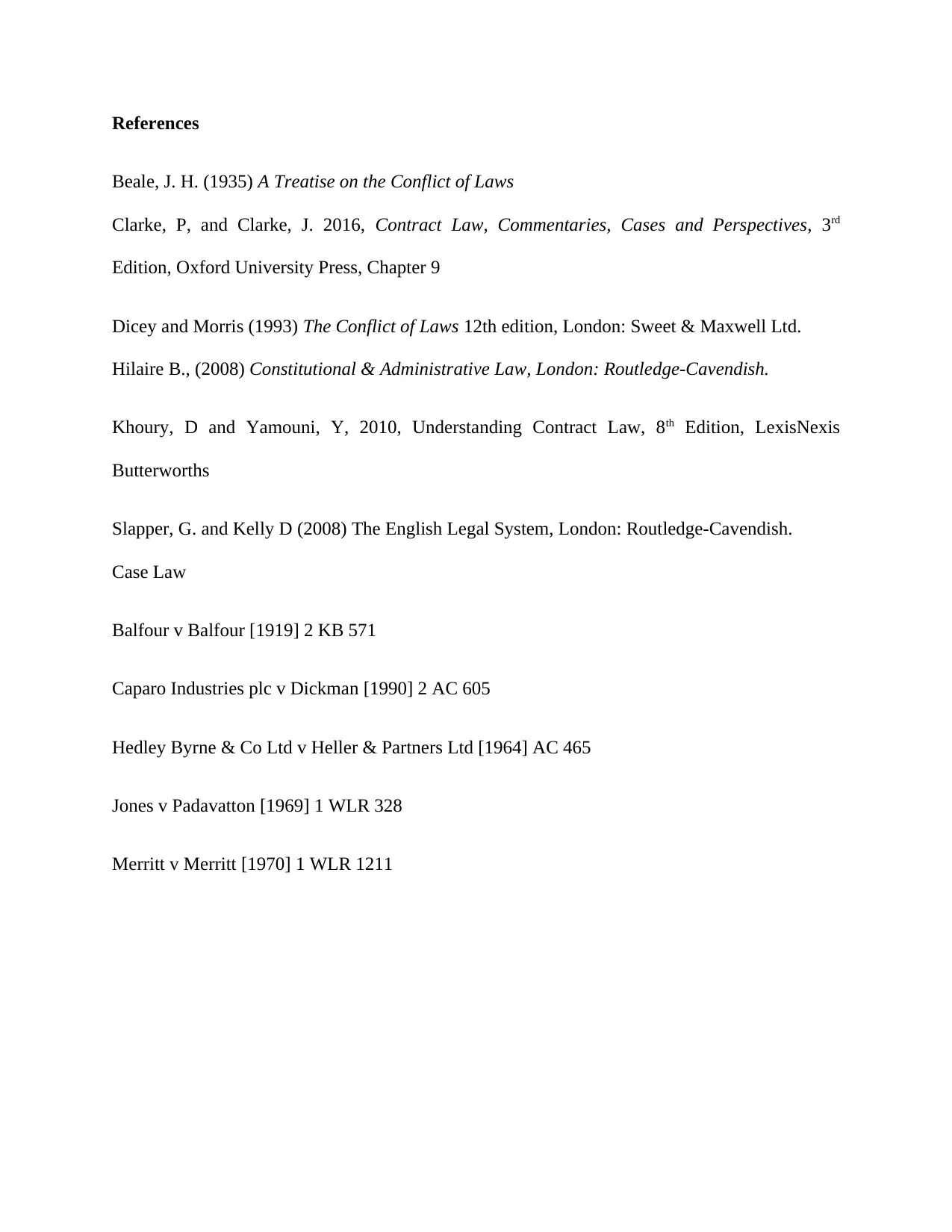
References
Beale, J. H. (1935) A Treatise on the Conflict of Laws
Clarke, P, and Clarke, J. 2016, Contract Law, Commentaries, Cases and Perspectives, 3rd
Edition, Oxford University Press, Chapter 9
Dicey and Morris (1993) The Conflict of Laws 12th edition, London: Sweet & Maxwell Ltd.
Hilaire B., (2008) Constitutional & Administrative Law, London: Routledge-Cavendish.
Khoury, D and Yamouni, Y, 2010, Understanding Contract Law, 8th Edition, LexisNexis
Butterworths
Slapper, G. and Kelly D (2008) The English Legal System, London: Routledge-Cavendish.
Case Law
Balfour v Balfour [1919] 2 KB 571
Caparo Industries plc v Dickman [1990] 2 AC 605
Hedley Byrne & Co Ltd v Heller & Partners Ltd [1964] AC 465
Jones v Padavatton [1969] 1 WLR 328
Merritt v Merritt [1970] 1 WLR 1211
Beale, J. H. (1935) A Treatise on the Conflict of Laws
Clarke, P, and Clarke, J. 2016, Contract Law, Commentaries, Cases and Perspectives, 3rd
Edition, Oxford University Press, Chapter 9
Dicey and Morris (1993) The Conflict of Laws 12th edition, London: Sweet & Maxwell Ltd.
Hilaire B., (2008) Constitutional & Administrative Law, London: Routledge-Cavendish.
Khoury, D and Yamouni, Y, 2010, Understanding Contract Law, 8th Edition, LexisNexis
Butterworths
Slapper, G. and Kelly D (2008) The English Legal System, London: Routledge-Cavendish.
Case Law
Balfour v Balfour [1919] 2 KB 571
Caparo Industries plc v Dickman [1990] 2 AC 605
Hedley Byrne & Co Ltd v Heller & Partners Ltd [1964] AC 465
Jones v Padavatton [1969] 1 WLR 328
Merritt v Merritt [1970] 1 WLR 1211
1 out of 7
Related Documents
Your All-in-One AI-Powered Toolkit for Academic Success.
+13062052269
info@desklib.com
Available 24*7 on WhatsApp / Email
![[object Object]](/_next/static/media/star-bottom.7253800d.svg)
Unlock your academic potential
© 2024 | Zucol Services PVT LTD | All rights reserved.




